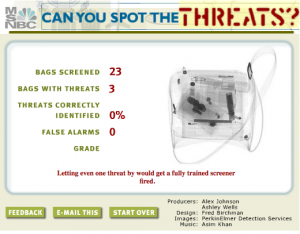UPDATE: December 6, 2011. Obviously, I wrote the post below several weeks ago. An end-of semester update coming soon.
We are now just past midterms this semester, and I can share the work done by the News Games class to remix the Food Stamp Game. As I have described in the two previous posts in this series, I created a very rudimentary, glitchy, incomplete game in Scratch designed to simulate the experience of shopping on a  food stamp budget. My idea was to have the students critique the game and remix it both as a game and as journalism. The image at left is a screen shot of the flash-based prototype they created. We had less time to work on this project than I had anticipated because Hurricane Irene and our Labor Day schedule forced a late start to the semester. Still, students reported that they found the experience valuable, both as an introduction to the course, and as a way of building community.
food stamp budget. My idea was to have the students critique the game and remix it both as a game and as journalism. The image at left is a screen shot of the flash-based prototype they created. We had less time to work on this project than I had anticipated because Hurricane Irene and our Labor Day schedule forced a late start to the semester. Still, students reported that they found the experience valuable, both as an introduction to the course, and as a way of building community.
In addition to their contributions to the game, students wrote reflective essays critiquing their work as journalism and as a game.
The focus of their effort was on enhancing the storyline, as well as improving the esthetics and the gameplay. With more time, they wanted to create more player profiles (a single parent with children, an unemployed adult, a retiree, etc.) to illustrate varied scenarios under which people acquire Supplemental Nutrition Assistance Program (SNAP) benefits. They also would have make hotspots out of more of the items, and they would have added a corner store or bodega to the shopping options.
From here, the students moved toward developing their individual game projects, which have turned out to be quite varied. In thinking through how I expected them to incorporate journalism into the game design and development process, I adapted my approach to teaching students to do long-form magazine writing. I will elaborate on this in my next post.
